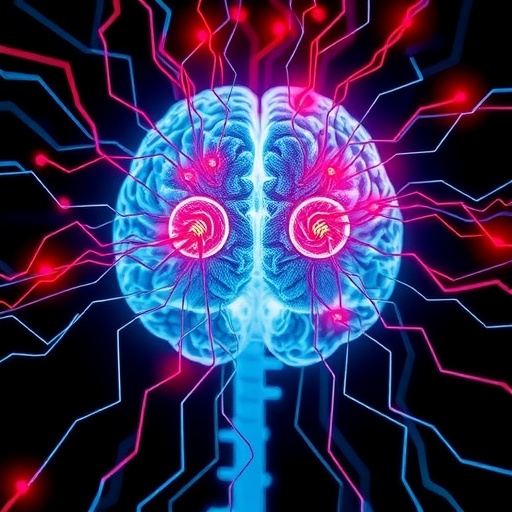In a groundbreaking study published in BMC Psychiatry, researchers have advanced our understanding of the complex neural mechanisms underlying facial emotion recognition impairments in deficit schizophrenia (DSZ). Using cutting-edge functional near-infrared spectroscopy (fNIRS), a non-invasive neuroimaging technique that measures brain activation through oxygenated hemoglobin changes, this investigation sheds light on how specific prefrontal cortex (PFC) dysfunctions correlate with emotional processing deficits distinctive to this subgroup of schizophrenia.
Schizophrenia, a chronic and severe mental disorder, presents heterogeneously across patients. Distinct subtypes—deficit and non-deficit schizophrenia—are characterized by differences in symptom severity and cognitive impairments. Deficit schizophrenia is particularly marked by persistent negative symptoms such as diminished emotional expression and motivation, and prior clinical observations have noted more profound impairments in recognizing facial emotions compared to non-deficit schizophrenia. However, the precise neurobiological underpinnings of these functional deficits remained elusive until now.
The study recruited 126 participants, encompassing 38 individuals diagnosed with deficit schizophrenia, 49 with non-deficit schizophrenia, and 39 healthy control subjects. All participants were subjected to a visually standardized task requiring discrimination of various facial emotions, including anger, sadness, contempt, and happiness. Concurrently, the researchers employed fNIRS to monitor real-time activation patterns within the prefrontal cortex, focusing predominantly on the dorsolateral prefrontal cortex (DLPFC, Brodmann area 9) and the frontopolar cortex (BA10).
Advanced statistical analysis revealed striking differences among the groups. Compared to the non-deficit schizophrenia cohort, those with deficit schizophrenia displayed significantly attenuated oxygenated hemoglobin (HbO) activation in the DLPFC and frontopolar cortex during the tasks involving recognition of anger, sadness, contempt, and happiness. These findings indicate a distinctive neural dysfunction that may underpin the exacerbated facial emotion recognition deficits seen in DSZ.
Moreover, when benchmarked against healthy controls, patients with deficit schizophrenia showed prominent reductions in prefrontal activation during tasks recognizing anger and happiness, reinforcing the notion that DSZ is associated with profound cognitive and emotional processing anomalies. During the contempt recognition task, decreased activation was specifically localized to the DLPFC compared with healthy individuals, suggesting that unique neural circuits are differentially disrupted across emotional categories.
One of the pivotal insights from this research lies in the moderate negative correlations found between prefrontal activation levels and the severity of negative symptoms in DSZ patients. This inverse relationship means that lower activation in BA9 and BA10 was associated with higher clinical scores indicative of diminished emotional expression and motivation. Interestingly, these neural-behavioral correlations were not observed in non-deficit schizophrenia patients or healthy controls, highlighting a neurobiological hallmark unique to the deficit subtype.
The utilization of fNIRS technology offered several advantages. Unlike functional MRI (fMRI), fNIRS is more flexible and less restrictive, allowing for real-time monitoring of cortical oxygenation during cognitive tasks without the need for a confined scanning environment. This methodological approach facilitated the examination of dynamic brain-behavior relationships during facial emotion recognition, a crucial aspect of social cognition severely compromised in schizophrenia.
The findings contribute a nuanced understanding of how prefrontal cortical dysfunction specifically differentiates DSZ from NDSZ, underpinning the more severe social cognitive impairments characteristic of the deficit form. Identifying these distinct neural signatures holds promise for refining diagnostic criteria and tailoring interventions that target the underlying neuropathology in DSZ.
Clinically, these results underscore the importance of emotional processing deficits in shaping the symptomatology of deficit schizophrenia. Therapeutic strategies that aim to enhance DLPFC and frontopolar cortex function might alleviate the social and motivational impairments challenging patients with DSZ, potentially improving quality of life and social integration.
Additionally, this study highlights the indispensability of precise subtype classification in schizophrenia research. By dissecting the neurofunctional disparities between deficit and non-deficit schizophrenia, researchers pave the way for more personalized medicine approaches, moving beyond broad-spectrum treatments toward targeted cognitive rehabilitation.
The authors emphasize that their research opens new avenues for investigating the neurobiological substrates of complex psychiatric symptoms. Future studies utilizing larger cohorts and longitudinal designs are needed to validate these findings and explore causative mechanisms linking PFC dysfunction to clinical outcomes in deficit schizophrenia.
In summary, this compelling fNIRS investigation elucidates the neural deficits associated with emotional recognition impairments in deficit schizophrenia, bridging clinical symptomatology and cerebral physiology. By illuminating the prefrontal cortex’s critical role in this process, the study provides a foundational framework for novel diagnostic and therapeutic innovations in schizophrenia’s most challenging subtype.
Subject of Research: Neural mechanisms of facial emotion recognition deficits in deficit schizophrenia via prefrontal cortex activation patterns measured with fNIRS.
Article Title: Neural association between mental symptoms and facial emotion recognition in deficit schizophrenia: an fNIRS study
Article References:
Hu, Y., Yang, G., Zhang, H. et al. Neural association between mental symptoms and facial emotion recognition in deficit schizophrenia: an fNIRS study.
BMC Psychiatry 25, 1108 (2025). https://doi.org/10.1186/s12888-025-07558-w
Image Credits: AI Generated
DOI: 10.1186/s12888-025-07558-w (Published 20 November 2025)




